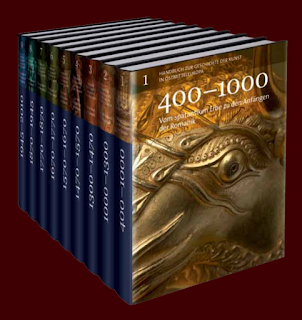The first volume of a very ambitious project of the Leibniz Institute for the Hiistory and Culture of Eastern Europe (GWZO) in Leipzig has finally appeared. The project aims to publish a new series of a Handbook on the History of Art in East Central Europe in 9 volumes. The series will provide an overview of art in the territories between the Baltic, the Black and the Adriatic Seas from the Early Middle Ages up to the present day. The Handbook series represents the first attempt to discuss the history of art of this entire region in a complex matter and in a European framework. Each volume in the series will contain about 650 pages, with essays and about 300 catalog entries, as well as plenty of illustrations.
The first volume, which is out now, focuses on the period of the early Middle Ages, from the time of the disintegration of the Roman Empire to the establishment of the new, Christian kingdoms of Bohemia, Poland, Hungary and Croatia. The time around the turn of the first millennium is commonly seen as marking the beginning of art history in Eastern Central Europe. New kingdoms and the adoption of Christianity gave rise to new impulses to architecture and the arts. Volume one of the handbook series examines the prerequisites of and precursors to this epochal change, including Late-Antiquity and early Medieval churches in the eastern Adriatic, golden treasures from the Migration Period, jewelry of the Great Moravian Empire, and everyday culture of the Slavic peoples.
The following two volumes in the series will also focus on the Middle Ages, dealing with Romanesque and Early Gothic art, then High and Late Gothic - with volume 4 dedicated to Late Gothic and Renaissance art. Look out for them in the coming years! To get a better idea of the entire series, have a look at this flyer.
Christian Lübke (Hrsg.), Matthias Hardt (Hrsg.): Handbuch zur Geschichte der Kunst in Ostmitteleuropa 1. Vom spätantiken Erbe zu den Anfängen der Romanik, 400–1000.
Berlin-München, Deutscher Kunstverlag, 2017.
652 pages, 600 illustrations, 21 x 27,5 cm, € 98.00
Berlin-München, Deutscher Kunstverlag, 2017.
652 pages, 600 illustrations, 21 x 27,5 cm, € 98.00
Finally, a word about the object on the cover of volume one. It is a detail of one bull's head bowls from the Treasure of Nagyszentmiklós (Sânnicolau Mare, Romania), uncovered in 1799 and now preserved at the Kunsthistorisches Museum in Vienna. Widely believed to be connected to the Avar Khaganate and dating from the 8th century, the treasure looms large in Hungarian national consciousness, as for a long time it was believed to be of Hungarian origin from the time of the Magyar conquest. A quick look at the popularity of the bull's head bowl as an architectural decorative motif around 1900 can illustrate this - see this article in Art Nouveau Magazine.
 |
| Bowl from the Nagyszentmiklós Treasure, Vienna, KHM |
















































